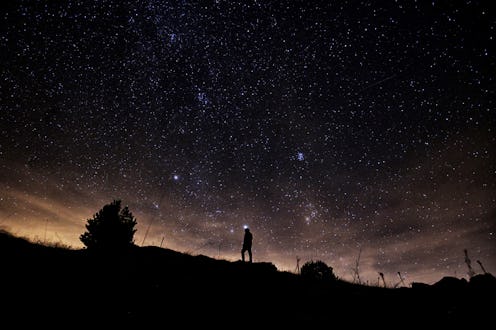Life
What Is The Eta Aquarids Meteor Shower?
Every year, the first week of May has many of us camped outside and gazing up at the sky, waiting for the evidence that Halley's Comet is still hanging around somewhere — because amazingly, it still makes an appearance of sorts every year. Some people aren't well-acquainted with what the Eta Aquarids meteor shower is, but it truly is a sight to behold. Halley's Comet last visited in 1986 and only returns approximately every 75 years, meaning that most of us will likely only see it once (maybe twice, if we're lucky); thanks to the Eta Aquarids, though, which was spawned by the comet, we can at least catch a glimpse of it during the spring each year.
During the Eta Aquarids, debris sheds from the giant ice-and-dust ball that is Halley's Comet, thus creating the annual meteor shower. Comets are largely considered "dirty snowballs," and they're left over from the creation of stars and planets from billions of years ago. So when you think about it, getting to witness the Eta Aquarids meteor shower is kind of remarkable. You're quite literally experiencing history — really, really, really old history. The Aquarids are known for how fast they move, traveling into Earth's atmosphere at about 148,000 miles per hour. In fact, they move so fast that they sometimes leave little trains of debris behind them that can last from a few seconds up to a few minutes.
If you're currently south of the equator, you're all but guaranteed a good show, possibly 20 to 40 meteors per hour. This year is predicted to be especially exciting because we'll have a new moon, meaning there will be extra dark skies perfect for meteor-hunting. For those of us in the Northern Hemisphere, however, we might have a more difficult time. While Texas and the Florida Keys will get some action (about a dozen meteors), head to New York City and your chances of spotting any meteors are much slimmer. It all has to do with where the meteor shower originates (a region called the "radiant point"), along with the fact that sunrise arrives earlier in the Northern Hemisphere.
The big show is happening today and tomorrow — May 5 and May 6 — but you'll need to head outside around 1:30 a.m. to catch it (which means you've already missed Thursday's viewing, unfortunately). And don't worry: If you happen to miss it, Halley's Comet has another meteor shower every October called the Orionids.
